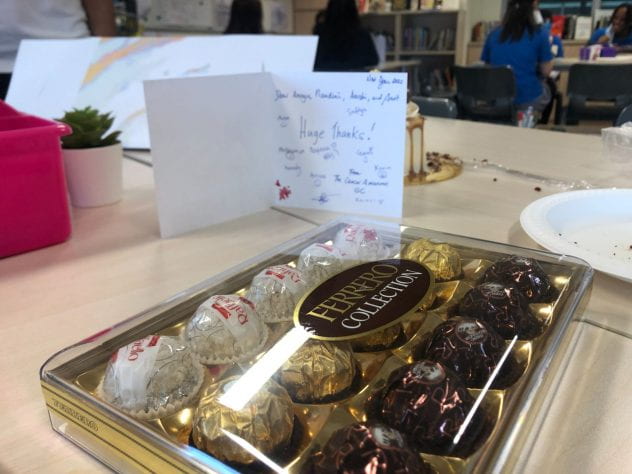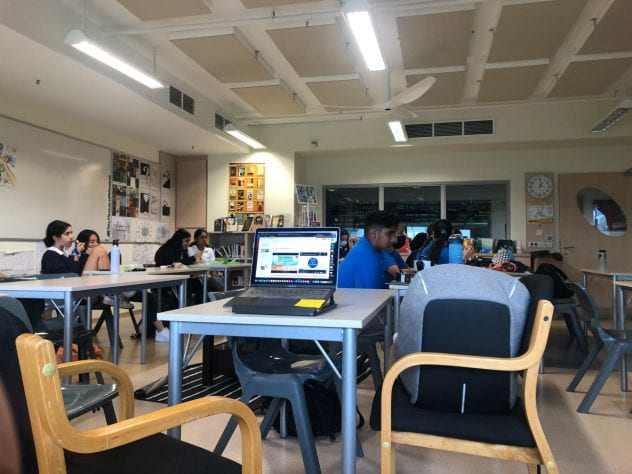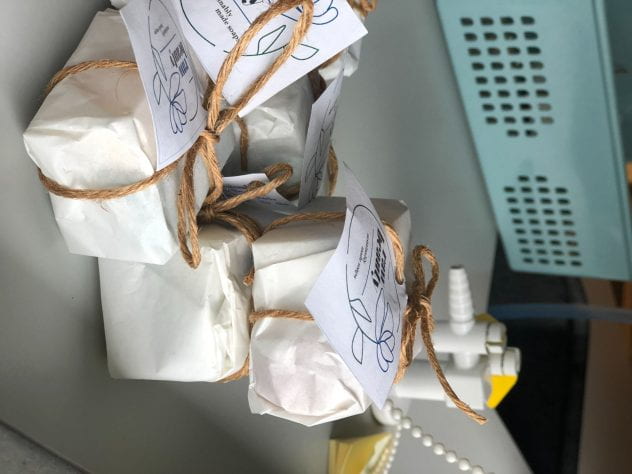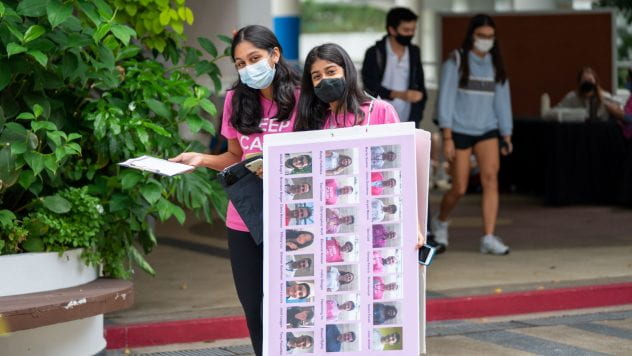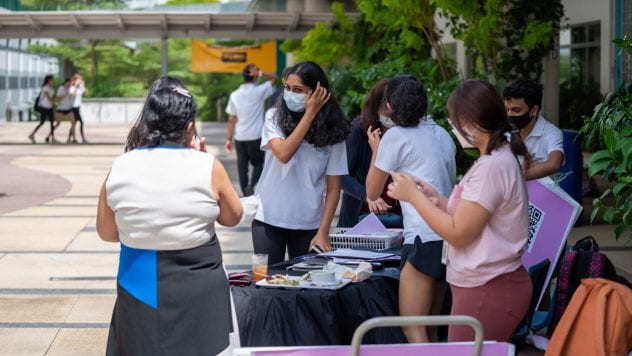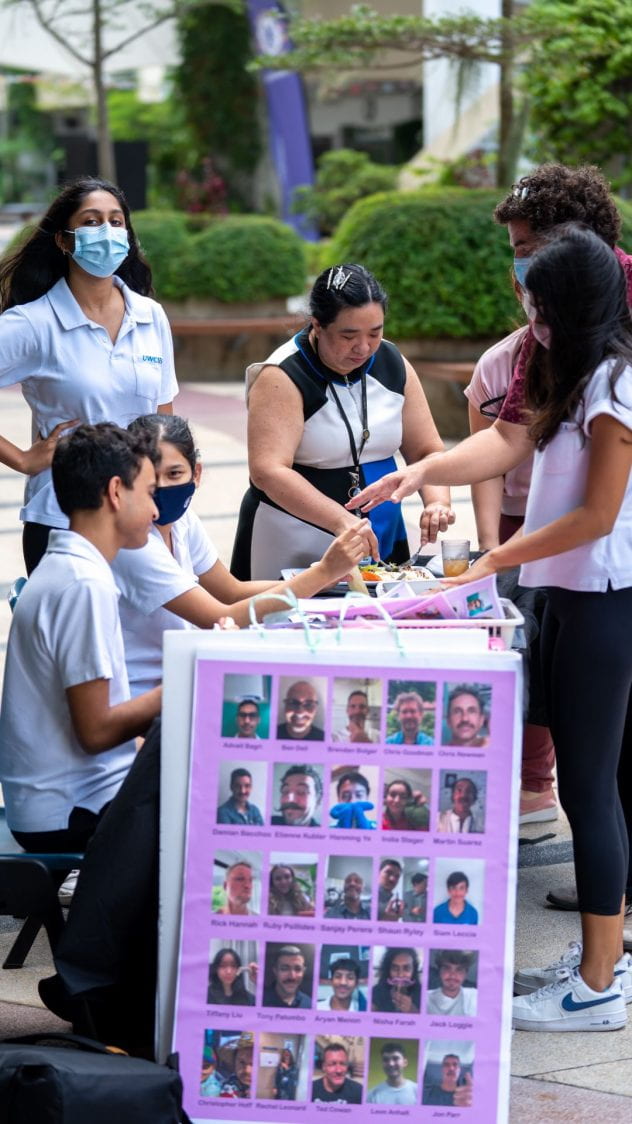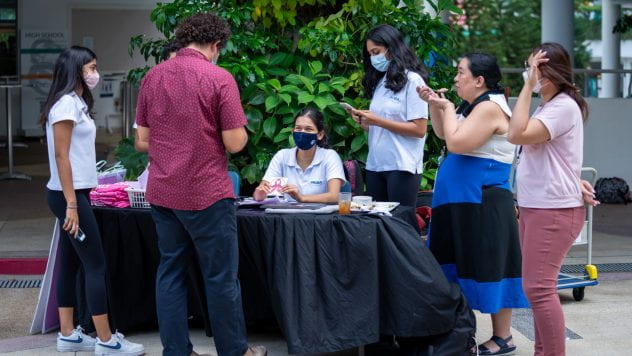https://drive.google.com/file/d/1b6MVH_l7iYDeKwzCnyHlsiH_2ly-jJgt/view?usp=sharing
Author: ganes39839@gapps.uwcsea.edu.sg
Cancer awareness : Wrapping up
My wonderful teacher facilitator hosted a warm celebration to thank us four chairs and the whole group for our successful Movember. I feel an immense amount of gratitude to have joined this service in grade 9, and to have worked with a group of amazing change-makers.
Cancer awareness has been instrumental in teaching me about how cancer awareness is a global issue that ties everyone together. Cancer is a disease that has the potential to affect anyone, even those who cannot bear the costs. As a result, it creates a social divide, between those who have resources for treatment, and those who must deal with it until it takes over. Therefore, I feel honoured to play a role in conducting this event, as it reminds me of how this is important to people that I may not meet, but I know exist. (LO6)
The ethical aspect of conducting this event and supporting this cause has also become clearer as I approach my last year in cancer awareness. We talk in class about the stigma surrounding cancer, and the idea of blaming individuals who have gotten cancer by zooming into their lifestyle habits. It’s taught me a lot about how to approach and interact with people who have been either directly or indirectly affected by cancer. Through Movember, I hope to play my part in eradicating the stigma of cancer and revealing the emotional impact cancer can have on an individual (lo7)
Bersama : Finishing up in Grade 12
Getting into Bersama after submitting my audition was a gratifying experience. I felt overjoyed in realising that I could carry on the moments I had in grade 11 over to grade 12, with new faces and new projects.
This year, I’ve taken on a different role by transitioning from alto to soprano. This change felt small at first, but I realise that becoming soprano has changed my perception of our songs. Rather than singing the melody, I’ve had to learn to complement the alto singers by singing in a higher key. Although higher keys are not my strength, I worked on them outside of bersama rehearsals and practiced the techniques my teachers have taught me (LO1).
Additionally, our group has changed a lot this year, the collaborative aspect of Bersama has remained unchanged. I find it exciting when we, as a group, brainstorm ways to edit certain parts of our score, change the tune/melody, or even deciding what song we should learn next. Bersama never fails to remind me how collaboration is an opportunity I’m eternally grateful for, as without it, I wouldn’t be the singer I am today (LO5)
Videos of me and my friend singing in class (Dancing Queen, Eleanor Rigby) :
https://drive.google.com/file/d/1yc-weuQv4FrExuYcix1YJvvNTJTZzl1H/view?usp=sharing
https://drive.google.com/file/d/1T4QItQ_tRPnINQ8n-pqkvD4eQEihgh5y/view?usp=sharing
Raw Beauty : Grade 12 reflection
Introduction presentation I made for the first session
: https://docs.google.com/presentation/d/19djZSgBkjVOAaV_pZVKBBhEAipTEd6T9/edit?usp=sharing&ouid=118120026354714215299&rtpof=true&sd=true
As I begin the process of handing over this service to the new grade 11 chair, I’ve begun to reflect on how Raw Beauty has changed me. It was my first experience becoming a leader of a service that didn’t have history, therefore, I had to co-plan and initiate many aspects to get it off the ground. It was a very fulfilling experience, as I garnered skills ranging from soap-making to leading (LO2) which are skills that remain with me even after Raw beauty.
But more than this, I realise that I’ve come out of Raw beauty with a different mindset than I had when I entered. I had never researched or explored the topic of child labour, specifically mica-mining, until I learned about it on my first Raw Beauty session. It changed the way I consumed not just beauty products, but everything in general. I’ve learned about what indicators to look for when seeking environmentally and ethically-friendly products (LO6) as a means to engage with an issue bigger than myself, one that is globally significant.
In relation to this, my awareness on what is ethically right and wrong has amplified thanks to my learnings in Raw Beauty. As a member, I realised that the new habits I incorporate into my life as a result of my learnings can be applied to the rest of my household. In realising that ethical consumption is not a act of service, but rather, a moral obligation, has helped me to frame my consumption patterns better and align them with my values. I’m thankful that a service like Raw Beauty has not only given me practical skills, but also, values like global and ethical awareness to tackle other issues I might face after my time at UWCSEA (LO7).
Our first soaps we made, using sustainable materials :
Teaching our grade 9’s how to make soaps from scratch using lye water. We had to inform them of the safety precautions we must take when handling pure NaOH.
ITP: Grade 12 reflection
In ITP, I have the opportunity to direct the lesson and choose what I want to learn. As a result of my many years in Carnatic (Indian classical) vocal music, I tend to request my teacher to teach me unfamiliar areas of music. An example was musical theatre, where I didn’t know how to sing a musical number, but dove into it so that I could audition and be part of the school musical.
For a university application, I decided to submit a musical supplemental video, to showcase my experience in the vocal arts. One of the requirements was to include a western classical piece, which I didn’t know. My teacher and I began the planning process. I began to line out my goals for where I’d want to be leading up to the final date (where I would film the video with a pianist), and began listening to other western classical pieces to gauge the style of music. This helped me become garner skills in planning and initiating CAS experiences (LO3) as I understood the important of goal-setting and having a long-term perspective with respect to my CAS experiences.
Additionally, since western classical was an unfamiliar area of music for me, I realised that my weaknesses were quite explicit in the start. The style of singing and performance was not only unfamiliar, but it was based on skills that I didn’t require, therefore didn’t garner, through my years of singing pop, Indian classical, western jazz, etc. There were some basic improvements, like how to carry yourself when you perform western classical. Then there were deeper improvements, like how to change your pronunciation to enunciate and produce a better sound. This helped me with developing my areas for growth and improvement (LO1), as I became engrossed with a style of music that initially played against my strengths.
Lastly, this mini-project helped me reiterate skills like perseverance and commitment (LO4). I was entrusted with the responsibility of organising a pianist, extra rehearsals, appropriate room and filming materials, and although it was overwhelming, especially in the midst of school and other commitment, I felt joy and gratitude in realising how far my commitment had taken me. I enjoyed filming this video as it was an amalgamation of my vocal training and experiences.
Link to the video: https://drive.google.com/file/d/1uLxSwyXOQeZztZa50bzs-Bh2h7z-pZG3/view?usp=sharing
Cancer Awareness : Movember 2021
My last Movember was an incredible success! Having raised more than 8000 dollars, I’m reminded of how lucky I am to be part of such an important event that supports an amazing cause and organisation.
This year, aside from co-leading the event, I also focused on handing over the service to the grade 11 chairs, who were so organised and responsive in conducting their first Movember. Regardless, I come away from my last Movember with a better awareness of my strengths and weaknesses, as well as the importance of the cause I’m fighting for.
I got the opportunity to delegate roles again, but this time, based on the new restrictions COVID posed for our event. I learned more about how to delegate roles effectively, such that people are assigned jobs that they enjoy but can also improve by bringing in new ideas. This was important when I was delegating where students would bring donation bags and sandwich boards (as you can see in the photo below) to areas within the school. I had to choose it based on how many people would be there, and whether students could effectively promote our cause to that audience. In the end, I thought that students could present it to people in their own grade, so that the level of familiarity could help in a deeper engagement and awareness of this event (LO3 (LO1)
Additionally, I come away with an understanding of how cancer awareness is not just a service event, but it’s a global issue that ties everyone together. Cancer is a disease that has the potential to affect anyone, even those who cannot bear the costs. As a result, it creates a social divide, between those who have resources for treatment, and those who must deal with it until it takes over. Therefore, I feel honoured to play a role in conducting this event, as it reminds me of how this is important to people that I may not meet, but I know exist. (LO6)
The ethical aspect of conducting this event and supporting this cause has also become clearer as I approach my last year in cancer awareness. We talk in class about the stigma surrounding cancer, and the idea of blaming individuals who have gotten cancer by zooming into their lifestyle habits. It’s taught me a lot about how to approach and interact with people who have been either directly or indirectly affected by cancer. Through Movember, I hope to play my part in eradicating the stigma of cancer and revealing the emotional impact cancer can have on an individual (lo7)
Practice IO – Wena Poon and Georgette Chen
For this oral, I chose Wena Poon’s ‘Development’ (short story) and Georgette Chen’s painting, ‘Malay Wedding’. One thing I did differently from the last practice IO was I avoided writing a script. Instead, I made the 10 bullet points I wanted to convey first, and then worked backwards. Although this strategy was unconventional for me, as someone who generally goes overtime and has a hard time cutting down on words, it definitely helped me prioritise the points that had to be conveyed.
I think this was a strength, and with the feedback I’ve received, it made me speak more fluently and I was able to look at my list of 10 points less frequently since I was familiar with it (having used it as the foundation for my ‘script’ since the beginning). I think this is a strategy I’ll use for my real IO.
One thing I need to work on is balancing between both texts. Often times I found myself referring back to points about text 1 while talking about text 2 that I had forgotten to include, which made my ideas slightly disorganised. In order to remember the order in which I want to introduce my ideas, I should try memorising key links/connections that tie specific points together, and help me speak in sequence.
Overall I think this practice helped me understand the expectations of this assessment, and the format it will be conducted in. I think, like all assessments, stress is a factor that I can’t fully prepare for. But I’ve understood that memorising a script wouldn’t be my chosen strategy. Instead I’ll focus on thoroughly understanding the points I want to include and why I want to convey them in that order.
Georgette Chen : Pastiche writing task
Chosen text – obituary
Sources used : Tommy Koh’s interview in The Straits Times
Renowned ‘global artist’ GEORGETTE CHEN, dies at age 86 in Singapore, after leaving behind a rich and beautiful legacy across the world

Georgette Chen (Chang Li Ying) was born in 1906, China, to a wealthy antique dealer with businesses in London, Paris, and New York. From a young age, Ms.Chen was set on pursuing art. Her artworks were influenced by the experiences and perspectives she obtained throughout her life, which coincided with both world wars and the Chinese revolutions. Ms.Chen’s first husband, Eugene Chen–acting foreign minister during Sun Yat Sen’s presidency–died as a prisoner of war in 1944 in Shanghai. In 1947, Ms.Chen married Ho Yung Chi. The couple moved to Penang in 1951, shortly before they divorced and parted ways.
Ms.Chen started a new chapter by moving to Singapore to teach at NAFA in 1953. Students and colleagues have spoken of Ms.Chen’s affinity for the Malay community, as many of the painting in the National Gallery exhibition showcase Malays, and she also learnt to speak the language. Singapore’s multiculturalism is what inspired Ms.Chen to use local scenery to develop her own painting style. The many friends she had, some that included her own students, support the claims regarding her friendly, social nature. During her time at NAFA, Ms.Chen lived through Singapore’s independence in 1965, and became a pioneer artist who is part of Singapore’s first-generation community, making her a prominent figure in the birth of Singapore’s culture and identity.
Ms.Chen passed away on 15th March, 1993, in Mount Alvernia Hospital. Ms.Chen’s estate was auctioned off, and her investments were sold off in shares and stocks. Her proceeds were distributed to worthy causes such as the Georgette Chen Arts Scholarship, community welfare projects for the Malay community, and a new building for the Singapore Council of Women’s Organisations.
Despite leaving no heirs, Ms.Chen’s legacy will be carried forward, and she will forever be recognised as a trailblazer of the Singapore art movement.
Memorial details:
Date : 16th March, 1993, 6pm
Thank you to the Straits Times, close friends of Georgette Chen, and the NAFA institution.
“Art to me is a labour of love and like such labours expects neither gain nor rewards and brings meaning into one’s life” – Georgette Chen
Conventions :
- Length : I’ve noticed that obituaries are generally brief, perhaps because can take up a maximum portion of a newspaper, or because they only include factual/general information on the individual. Personal, emotive details and stories are used in the eulogies, which are longer.
- Formality/tone : In obituaries, the objective is to inform–as a form of respect–the audience, not limited to family/close friends, about someone’s death. As a result, the tone is generally formal and the deceased individual is referred to as their full name or Ms/Mr––. This contrasts a eulogy, or Tommy Koh’s interview, where individuals will be free to use their personal nicknames as a way of recollecting their relationships and memories with the person in an authentic, personal way.
- Background info – all obituaries include basic information such as year of birth, profession, marriages, family/children, etc
- Memorial – because obituaries are posted soon after the person’s death and shortly before the memorial, a public memorial might have the address/timing details written on the newspaper for the reader’s reference
- Photo – the photo of the deceased individual is generally one of them looking happy, and of a younger version of themselves from a while back, perhaps as a way to get people to reminisce about that person’s whole life, rather than just the end.
- Heading/titles- Especially in obituaries where the deceased individual is someone celebrated/significant, they are given a title to exemplify their impact and legacy. In this case, Chen was a crucial stakeholder in the becoming of Singapore’s culture and artistic identity, therefore I chose to use that as I crafted a name for her (Global artist, trailblazer)
What is implicit and visible only through knowledge of conventions, context, and stylistic choices?
This text is a brochure created by the National Gallery in Singapore, promoting Georgette Chen’s exhibit. Georgette Chen (1906-1993) was an artist who travelled/lived around the world before starting a new chapter in Singapore. Georgette Chen was an artist who lived through world war 1 and 2, as well as the Chinese revolution, and pioneered the ‘Nanyang’ style of art.
As she moved Singapore, after divorcing her second husband, she moved to Singapore when it was still a part of Malaysia. Chen’s life and experiences that are depicted in her artwork show the birth of Singapore’s culture through time. This brochure–although it explicitly presents information regarding Chen’s life and her artwork–implicitly represents Singapore as a multicultural capital by using Chen’s life as proof that Singapore’s culture is not only separate to their Malaysian history, but that it has existed for a long time.
Emphasising small details about Chen’s personality (As they mention she used to paint with her friends..) humanises her and creates common ground between the exhibit and viewer/reader. This widens the target audience. Instead of using artistic terminology and specifying art techniques/styles, they’ve highlighted Chen as a Singaporean individual. Her experience working at NAFA and teaching locals, contribute to this idea that Singapore played a significant role in Chen’s life and path to success as an artist. Yet in Chen’s artwork contains still-life scenery of people, nature, Singaporean fruits, instead of typical war scenes that Chen must have experienced during the global events she lived through. Additionally, during Chen’s career in Singapore, the initial stages of this city/state’s independence, the primary goal must have been economic development. But her work shows a different side of Singapore, the connected, diverse side. This might signify that, as Singapore is currently known as a hub for finance/technology/business, this is the ‘Singapore’ that people like Chen want to put a spotlight on. This brochure shows Chen as someone who presented Singapore as a cultural capital, instead of using the struggles and wars she lived through as an inspiration to her art, the local, ordinary scenes are what inspired her.
Georgette Chen
I think this text type contains a mixture of elements from eulogies and obituaries. What makes it different is how it was written years after the individual’s death, probably signifying that it represents the Chen’s long-lasting significance to this day. In terms of context, her work was prevalent in Singapore because of how it was multi-cultural and exhibited Singapore’s diverse population. But at the same time, her own life, having lived in and out of Asia, represents an amalgamation of cultures and values that she conveys through her work. I think the purpose of this text, like a Eulogy, serves to remember the individual and their impact. Like an obituary, it includes information on her life, her background, but diverts when it goes into depth on her personal life, relationships, and struggles. It could also serve as an opportunity to promote the exhibit as a cultural milestone for Singapore, as it exemplifies how she contributed and adopted Singaporean culture as she lived through the emergence of Singapore from Malaysia.
